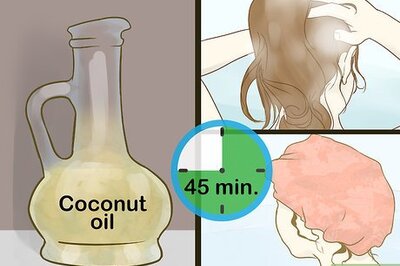
views
How common are brown eyes?
Brown eyes are the most common eye color. However, that doesn’t mean that they all look the same! Shades of brown vary from a very light honey brown to almost black. Brown eyes are most prevalent in Africa and Asia, making up about half of their populations. People with brown eyes have more melanin, which is a pigment that adds a darker tint to our eyes, hair, and skin. All humans are believed to have had brown eyes up until about 10,000 years ago, when a common ancestor had a genetic mutation that resulted in lower melanin, and thus, lighter eyes. All eyes are technically brown, but how they appear in color has everything to do with melanin and the scattering of light. If the iris, or the colored part of the eye, contains less melanin, it reflects more light, therefore leading to lighter-looking shades like green, blue, and hazel.
Shades of Brown Eyes
Brown eyes can be categorized from light brown to dark brown. Not all brown eyes are created equally! There is a spectrum of color that ranges from very light, caramel-toned eyes, to very dark brown eyes, where the pupil, or black circle in the center of the eye, and iris are nearly identical. Here are some color categories that experts have agreed upon. Light brown eyes. Light brown eyes have less melanin, as showcased in their shimmery, honey appearance. They might appear golden in the light and can be mistaken for hazel eyes. Cognac is another shade of light brown named after the brandy that is slightly darker than honey, with rusty red undertones, and could be mistaken for amber eyes. Medium brown eyes. This shade of brown is deeper and darker, with higher concentrations of melanin. Chestnut is one popular shade of brown, a romantic reddish hue that resembles chestnuts. Russet brown is a darker version of chestnut, with more orange undertones. Dark brown eyes. This shade is the darkest of the brown eyes, appearing like two deep pools of melted chocolate. Chocolate brown eyes offer a rich and intense shade of brown. Black-brown is the darkest shade of eyes possible, with the pupil and iris being almost indistinguishable. Black-brown eyes can be perceived as alluring.
Hazel is not considered brown. Hazel eyes are actually a combination of brown, green, and gold. Most hazel eyes contain 2-3 of these colors, and this variable blend can make them seem like they’re changing colors. People with hazel eyes have less melanin that those with brown eyes, but more than those with green eyes, which is the rarest eye color, accounting for only 2% of the population. Hazel is a truly unique eye color, with some people having brown canvas with flecks of gold and green, green with flecks of gold and brown, or any variation of the three. Hazel is one of the trickiest eye colors to define as its appearance often depends on light, complexion, and the color of clothing a person is wearing.
Amber eyes are very rare, making up only 5% of the population. Amber eyes are named after the gemstone, which is orange-yellow in color. This is due to the high levels of pheomelanin, which is one of the two subcategories of melanin in the iris. Pheomelanin is orange-red in hue, underscoring the warm glow in the amber gaze. Some scientists still categorize amber as brown, although amber eyes can be several shades lighter and yellower in tone. Brown eyes contain more eumelanin than amber eyes, or the brown-black subcategory of melanin, which tips the scales over to the dark side.
Makeup Tips
Wear green, blue, and purple eyeshadows. According to color theory, these kinds of colors can help bring out the natural gold tones in brown eyes, helping them appear richer and more vibrant. Colors like amethyst, cobalt blue, pink, and teal best accentuate brown eyes and can be applied as eyeshadow all over the eye for a dramatic look. You can also find these colors in eyeliner pencils, opting for a fun pop in the corner of the eye. Makeup artist and hair stylist Alicia D'Angelo suggests experimenting with bright colors, stating, “Any contrasting shade like pink, purple or blue will draw more attention to the eyes in general, making the eye color appear a richer, deeper brown.” D’Angelo recommends applying “sweeping soft, warm neutral brown tones in the crease [of the eye]” and pressing a “shimmering green, bronze or golden tone across the lid for a sexy, sultry look.”
Metallic eyeliners can add glitz and glamour. A touch of gold can add that X-factor to your makeup look, complimenting the warm radiance of brown eyes. D’Angelo agrees, adding that gold shimmers can bring out the amber in the eye, which will in turn render the eye color lighter. Bronze and copper eyeliners can offer a similar glittery effect with a bit more subtlety. These shades have metallic undertones, and are cross between brown and gold. Metallic shades can add depth and razzle dazzle without too much pigmentation, allowing those beautiful brown orbs to shine on their own.
Create a smokey look for brown eyes. A smokey-eyed look is perfect for brown eyes, intensifying their deep luscious color. The key to achieving a perfectly seductive smokey eye that still makes brown eyes pop is to lead with a brighter color, like blue or purple. Makeup artist, Charina Redugerio, offers a few expert tips on how to nail this smokey eye look for brown eyes. She shares, “When I say, ‘I'm going to put purple on your eyes,’ I know people tend to freak out because they think of the brightest fuchsia purple possible, but there's a classier way to apply it.” Although purple or plum would be the focal colors, she suggests blending it in with more golden browns and a bit of black. “The number one key to a beautiful smokey eye is to build up to it,” she offers. She notes that a common mistake for beginners is that they start with the darkest color first and lay it on thick. Instead, she advises that it’s easier to build more pigment than to remove, even if the process takes longer. According to Redugerio, trying to remove deeply pigmented color from your skin is how one ends up “looking like a raccoon,” so avoid this at all costs!
Interesting Facts About Brown Eyes
Brown-eyed people are less vulnerable to light and some diseases. The melanin in the iris adds a layer of protection, so brown eyes allow less light to pass through. This is part of the reason why brown-eyed folk tend to populate sunny, warm places, like Africa and Southeast Asia. High levels of melanin in the eyes, skin, and hair help protect people against these hot, tropical conditions. People with brown eyes are less susceptible to some diseases, like eye cancer, diabetic retinopathy, and macular degeneration. Due to UV exposure, however, brown eyes are more likely to develop cataracts than their blue or green-eyed counterparts.
Brown-eyed people are viewed as more trustworthy. A study revealed that people with brown eyes appear more humble, kind, and trustworthy than their lighter-eyed counterparts. To be fair, other factors were thought to influence this outcome, like face shape and eye size. Brown eyes offer a sense of familiarity, and could lead others to want to open up to you when coupled with a pleasant expression. People with brown eyes are thought to be excellent communicators, with a good life-work balance. Dark brown eyes point to confidence and assertiveness, resulting in formidable leaders.
Brown-eyed people have a lower pain tolerance. It’s not exactly good news for those of us with brown eyes, but a 2014 study showed that people with brown eyes have a lower pain tolerance than most others. 58 pregnant women were surveyed, and the results unveiled that the 24 brown-eyed women suffered from significantly more pain, discomfort, sleep issues, and depression than the blue-eyed pregnant women. Even after receiving epidural analgesia, the brown-eyed participants reported more signs of emotional and physical distress. Melanin production has been a known predictor of pain tolerance, and brown-eyes have it the worst, while red-haired people with lighter features tend to have the highest pain tolerance.




















Comments
0 comment